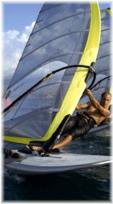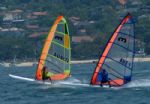2004 Olympic Selection Bid
1. OLYMPIC WINDSURFING SHOULD REFLECT THE COMPETITION FORMATS ON ALL LEVELS AND AROUND THE WORLD.
- IMCO equipment is raced in 70 countries worldwide at Youth and Senior level including 5 continental championships, one world championship and one youth world championship. In addition, there is a developing Asian Continental Racing Circuit containing 6 international events;
- IMCO is the second biggest fleet at the “Semaine Olympique Francaise” and at SPA; there are IMCO fleets in all the main Olympic Class Regattas in all continents of the world. The Mistral One Design is the current ISAF Youth World Championship official windsurfing equipment and is the current EuroSAF appointed Youth Windsurfing Equipment;
- The Mistral One Design is currently the official windsurfing equipment for the Asian Games, the Pan Am Games, The Small Island Games, the World University Games and the South Pacific Games amongst others;
2. OLYMPIC WINDSURFING SHOULD BE MODERN AND ATTRACTIVE FOR BOTH THE PARTICIPANTS AND THE MEDIA.
- There is currently only one Olympic sailing event, which uses more modern equipment (49er) than the Mistral One Design;
- IMCO, like any Olympic Class, has seen the level & quality of competition become higher in each succeeding year. Nationally, this has had the effect of reducing local fleets to either those competitors serious about “Going for the Olympics” or Youth Development squads. Inevitably, recreational competitors have left to race Raceboard or even FW as it is easier to be competitive and not so serious;
- IMCO racing is as attractive to spectators and the media as any other Olympic sailing event in fact probably more so because at the Pre-Olympics the spectator boats came to the “boards” course first in preference to viewing the 49ers or the Tornado catamarans;
- IMCO events get regular coverage in main stream national and regional newspapers;
- IMCO has made great strides forward in ensuring TV coverage of its events and worldwide distribution of the images. 5 TV stations covered the 1999 Mistral Worlds. The 1999 Mistral Europeans in Poland were covered by German and Polish National terrestrial TV and achieved viewing figures of 10m. per airing?
- When IMCO has the promotional budget to invite specialist “windsurfing” journalists to its events, it has achieved impressive coverage in the windsurfing press;
3. THE FORMAT AND EQUIPMENT SHOULD BE USABLE FOR COMPETITION ALL AROUND THE WORLD.
- IMCO equipment is raced in 70 countries worldwide at Youth and Senior level including 5 continental championships, one world championship and one youth world championship. In addition, there is a developing Asian Continental Racing Circuit containing 6 international events;
- IMCO is the second biggest fleet at the “Semaine Olympique Francaise” and at SPA; There are IMCO fleets in all the main Olympic Class Regattas in all continents of the world. The Mistral One Design is the current ISAF Youth World Championship official windsurfing equipment and is the current EuroSAF appointed Youth Windsurfing Equipment.
- The Mistral One Design is currently the official windsurfing equipment for the Asian Games, the Pan Am Games, The Small Island Games, the World University Games and the South Pacific Games.
4. THE EQUIPMENT SHOULD BE ACTIVELY RACED BY WOMEN WORLDWIDE.
- The Mistral One Design Women’s fleet is the biggest women’s windsurfing fleet on the planet;
- In the 1999 Mistral World Championship, 64 women entered. This represents 66% of the men’s fleet.
- There is a growing women’s fleet in the Asian Continental Racing Circuit;
- In a recent IMCO women’s forum, there was unanimous support for the Mistral One Design for 2004. Andrea Hoeppner, Barbara Kendall, Sigi Rondelez, and Alessandra Sensini, all of whom raced on the PWA circuit, are now racing the Mistral One Design and support it’s selection for 2004;
- Jessica Crisp, an ex-PWA World Champion, supports the Mistral One Design as the Olympic equipment for 2004;
- IMCO works hard to ensure equality of opportunity between the men’s & women’s fleets both in terms of wind conditions as well as TV coverage and prize money.
- At the 2000 World Championship, GEMS TV, a South American “Women’s Issues” satellite channel, covered the IMCO women’s fleet exclusively;
- At the 2000 Penta Mistral Cup, the prize money pool available to the women’s fleet was equal in size to the men’s fleet. Alessandra Sensini won US $10,000. No woman has ever won more in the history of windsurfing;
5. THE EQUIPMENT SHOULD BE PRODUCTION EQUIPMENT AND COMMERCIALLY AVAILABLE AROUND THE WORLD AND IF POSSIBLE FROM MORE THAN ONE MANUFACTURER.
- Mistral Sports GmbH is the largest distributor of windsurfing equipment in the world with the biggest dealer network;
- IMCO have reached agreement with Mistral Sports GmbH so that the One Design sails can be made under licence by any sail “loft” anywhere in the world between 2001 and 2004;
- IMCO will sell Mistral One Design spare parts through its e-shop based on the IMCO website so that competitors can buy at “retail price” direct from the factory for delivery anywhere in the world;
6. THE FORMAT AND EQUIPMENT SHOULD BE CAPABLE OF BEING USED IN A WIND RANGE FROM 6 > 35 KNOTS.
- The Mistral One Design Format allows racing to commence in 5>6 knots of wind and depending on the sea state, can continue up to 30 knots of wind;
- Since 1992 when IMCO was selected for the Olympics, we have never failed to complete a regatta due to lack of wind. In all cases, we have either completed the maximum number or races allowed or to within two races of that maximum;
- The current Mistral One Design Format allows the boards to race successfully at all times when other Olympic classes are racing. This will not be the case if FW is selected as the Olympic equipment;
7. THE EQUIPMENT SHALL BE OF HIGH QUALITY, DURABLE AND AFFORDABLE.
- A new Mistral One Design costs less than an Optimist;
- Production of the Mistral One Design has now been transferred back to Germany and is now built in the same factory as many FW “wide style” boards;
- Small nations like Fiji can compete on an equal footing with the rich ones. Tony Philp (FIJ) came 2nd in the 1999 Mistral World Championship;
8. OLYMPIC WINDSURFING SHOULD BE CAPABLE OF BEING COMPETED IN BY PEOPLE IN AS WIDE A PHYSIQUE RANGE AS POSSIBLE.
- Mistral One Design competitors in the men’s fleet have a weight range of 64 >80 Kgs and in the women’s fleet have a weight range of 50>67 Kgs;
- The 1999 FW World Champion weighed more than 90 kilos;
- By way of a comparison, in the late 70s and early 80s, when the windsurfer class was dominant, out of the 320 pre-qualified male sailors at their world championship the mid-point in weight terms was always 68>69Kgs… 25% of the fleet was under 64Kgs… 25% between 64 & 69Kgs… 25% between 69 & 76 Kgs… Only 25% was over 76Kgs and less than 10% was over 80Kgs
NB. The only exception to this weight spread was when the WC was held in Japan when the mid-point was much lighter!
9. THE FORMAT AND EQUIPMENT SHOULD REDUCE THE NEED TO PUMP, WHILST AT THE SAME TIME BEING AT LEAST AS PHYSICALLY DEMANDING AS IT IS NOW.
- The IMCO format is optimised to reduce the need to pump;
NB. At the 1998 ISAF Conference, The ISAF Council agreed that 6 knots should be the minimum wind speed for competition in Athens 2004.
10. EQUAL OPPORTUNITY FOR ALL NATIONS TO COMPETE AT THE HIGHEST LEVEL.
- There are over 70 Countries currently sailing & racing the Mistral One Design world wide;
- During 1999, we welcomed Belarus, Cuba, The Seychelles, Sudan, Tahiti, & Zimbabwe as National IMCOs making a total of 63;
- The six medals in Savannah went to 6 countries in 4 continents;
- At the 2000 Worlds, the top 3 men & top 5 women were from 3 different continents;
- Overall 52 Nations took part in the 2000 Olympic qualification series for boards; 48 nations in the men’s fleet & 33 in the women’s;
- Competitors from the “less well off” countries can afford to compete in IMCO Racing! Small nations like Fiji can compete on an equal footing with the rich ones. Tony Philp (FIJ) came 2nd in the 1999 Mistral World Championship;
- IMCO is pro-active in the development of Junior & Youth competition;
- Continental Regatta Series & Ranking Lists outside Europe enable development of national squads & offer international experience close to home inexpensively;
- The Class leaves a legacy behind following all major regattas – IMCO encourages the development of local race management teams in each continent;
11. COMPETITORS IN OLYMPIC WINDSURFING ON ALL LEVELS SHOULD NOT BE EXPOSED TO EXCESSIVE HEALTH RISKS.
- Mistral One Design Racing subjects competitors to less health risks and produces less injuries than other Olympic Classes;
- The health risks involved in Mistral One Design Racing are no greater than in any other windsurfing racing format.
12. THE RESTRICTIONS ON THE EQUIPMENT: 1 BOARD, 2 SAILS AND OTHER EQUIPMENT RESTRICTIONS TO LIMIT COSTS.
- Mistral One Design Racing Competitors in the Olympic fleet only use one board and generally, only one rig together with one fin and one daggerboard;
13. ATTRACT THE BEST & BEST KNOWN
- The best Mistral One Design Racers such as Bruce Kendall, Aaron MacIntosh, Nikos Kaklamanakis, Mike Gebhardt, Barbara Kendall, Jessica Crisp, Lee Lai Shan & Alessandra Sensini are the best in the world and are recognised as such;
- They are at least as good if not better than the best Funboard course racers;
- In Asia, Karin Jaggi is unknown by the general public, in comparison to Lee Lai Shan;
- In New Zealand, Bruce & Barbara Kendall are probably better known by the general public than Bjorn Dunkerbeck;
- In Greece, Nikos Kaklamanakis is better known by the general public than almost any other sailor of any kind;
- In Argentina, Carlos Espinola is better known by the general public than almost any other sailor of any kind;
14. PART OF THE PROGRAMME SHOULD LEAD THE SPORT AND ANOTHER PART SHOULD REFLECT THE SPORT.
- Mistral One Design Racing is the most widely practised format worldwide and thus reflects the sport.
So, please support….
IMCO, THE MOST SUCCESSFUL OLYMPIC WINDSURFING CLASS EVER
Appendix 1
Report to the ISAF about developments and future of Olympic
windsurfing




